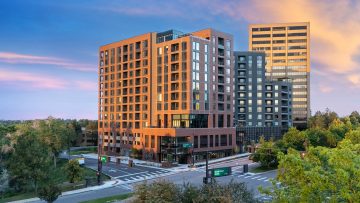
The premise of the HGTV show Extreme Makeover: Home Edition was that a deserving family would be gifted a crew of contractors, designers and building industry professionals who would enter a five-day blitz to totally transform the family’s residence into their dream home. As an architect who knows it takes around six months to build a single-family home, I was always skeptical of this supposed five-day construction turnaround but wondered if it could be possible.
In 2005, KTGY had the opportunity to participate in one of these projects and we learned it is, in fact, achievable. The key was not to think of it as a compressed six-month build but to rethink the process entirely. Designers, developers, contractors and fabricators needed to work together seamlessly to develop a roadmap — and it was only through this collaboration, planning and a reimagined approach that we were able to do the seemingly impossible.
The building industry is currently facing many challenges. Soaring development costs are compounded by rising interest rates. Climate change is driving the push for sustainability with building codes sending a clear message that this evolution is happening now. Electric vehicles, photovoltaics, battery storage systems, and initiatives like AIA 2030 and Energize Denver all promise a cleaner future, but they add to the bottom line today. High demand and low supply equal more upward pressure on costs. End users are ultimately absorbing these additional costs, but for how long before the system breaks? Housing attainability is under threat and something needs to change.
Modular Construction
One way to combat these challenges is to increase the speed of construction. The sooner a completed project gets to market, the sooner it may start generating revenue. Reducing construction duration reduces general conditions, overhead and labor costs for all parties involved. Additionally, freeing up resources sooner, makes them available for other projects. Speeding up construction is great in concept, but the trouble is in how it’s done.
Modular housing is one potential solution. It promises factory-built precision and efficiency, with the bulk of construction taking place in a weather-controlled, off-site environment. The building blocks are then transported before a nearly-complete building is assembled onsite. Modules must be staged somewhere before and after transportation or delivered just in time. Partnering with the right factory to understand their specifications, capacity and timing is critical. Like in “Extreme Makeover,” all the parts must come together in sync: the client, architect, engineers, contractors and factory must all work in lockstep to maximize efficiency.
Designers must understand how the limitations of transportation can dictate the size, configuration and interface of modules. The pieces need to be designed to allow for access and straightforward connections of structural components, utilities and weatherization. The underlying goal of maximizing what can be built in the factory must be balanced with protective measures for elements during transportation, and some elements will be better built onsite.
Materials
Mass timber construction addresses sustainability by reducing carbon output compared to concrete and steel structures. Building codes have recently embraced mass timber by introducing new construction types, allowing up to 18-story structures. Without the need to build formwork, reinforcement and pour concrete on each floor, assembling a kit of mass timber parts can shave off 25% of onsite construction time.
Steel systems still have their place in the market, and they’ve come a long way from the heavy, rivetted structures that once required putting skilled laborers in precarious positions. Modern steel systems, such as Infinity Structures & Prescient, are light-gauge proprietary systems that require less overall material, are built more precisely, and go up quickly. Most of these systems employ various degrees of panelization for the floor, roof systems and wall systems. The concept of panelization can also be applied to wood, with the added benefit of being a renewable material.
At the material level, manufacturers have made advancements combining multiple building materials, largely to reduce installation steps in the field. Zip System married exterior wall sheathing with air/water-resistive barriers and some versions even include insulation and/or fire protection. Structurally Insulated Panels (SIPs) sandwich insulation between layers of wood sheathing, providing a wall panel with both structural and thermal properties, durable enough to survive the rigors of transportation.
Off-site construction can be broken down into even smaller components such as modular elevator systems, stairs & balconies. These elements can be quickly bolted together onsite, reducing the need for skilled onsite labor and circumventing several sequencing challenges. There are efficiencies to gain even at the most basic level of construction, where building studs can be ordered precut to size and ready for assembly upon delivery. While these components are just small pieces of a larger building, this lends to more flexibility with transportation to the site.
Many concepts in off-site construction are not new, but the building industry has yet to take full advantage. If we think differently about construction and embrace these systems, methods, components and materials, then we stand to reap the benefits: faster construction, reduced overall costs and more sustainable construction. With the right knowledge and careful coordination between all stakeholders, we can begin to address the challenges facing our industry and get where we want to be, faster.
KTGY Principal Kyle Millar’s architectural experience has been predominantly focused on the residential multifamily sector where he has led design teams for a variety of projects ranging in density from single-family to mid-rise. The core of Mr. Millar’s experience has been in the technical project phases beginning with design development, leading into construction documents and extending through construction administration. He is committed to comprehensive project management to serve the client and deliver a finished product that maintains the quality and character of the original design. In 2023, Mr. Millar moved from KTGY’s Irvine office to Denver where he is leading the production team in the Denver High Density studio.

